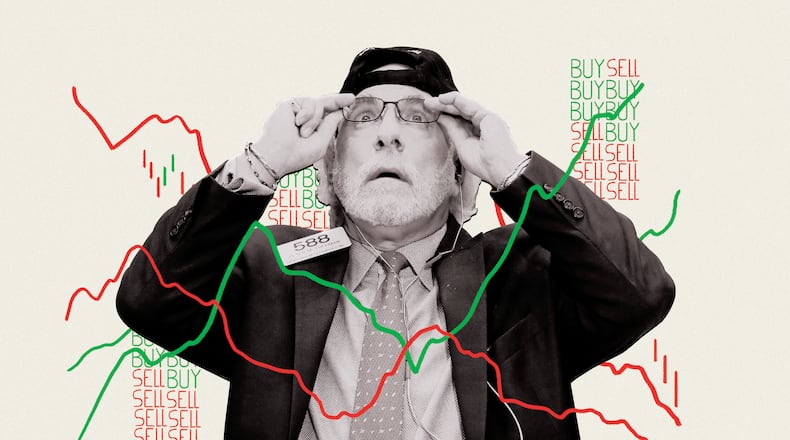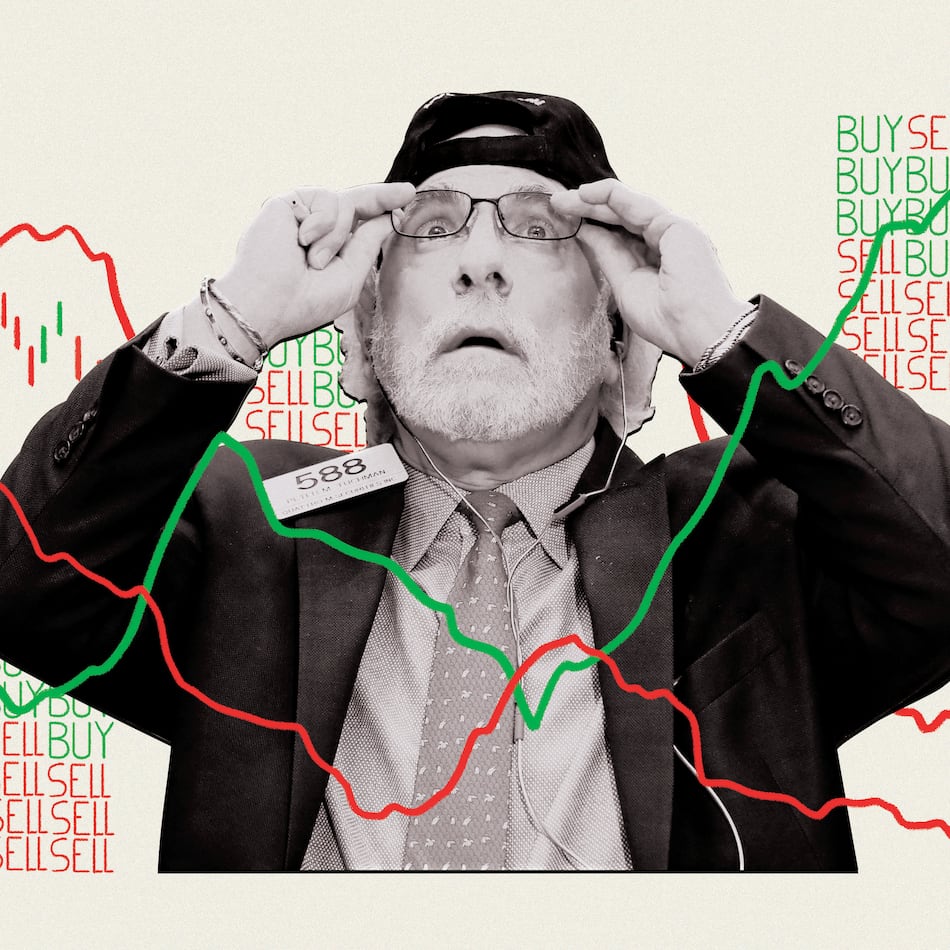Trashawn Mitchell-Stewart is worried, no way around it.
Ever since President Donald Trump announced sweeping new tariffs against almost every country in the world, Mitchell-Stewart has been looking for ways to cut back her spending.
“It just alarms me,” Mitchell-Stewart told The Atlanta Journal-Constitution. “I knew a lot of what we use is going to be affected by that.”
The volatility in the stock market, the looming threat of costs going up and the predictions of a possible recession all have the 49-year-old from Covington tracking every dollar she spends.
Over the past few weeks, she’s cut down on eating out and the spontaneous gifts she buys for her grandkids. She canceled her Netflix, Hulu and cable subscriptions. Now, she is comparing gas utility providers to see if she can lower that bill.
It’s all an effort to feel some “control of what you can have control of,” Mitchell-Stewart said, in a time of deep financial uncertainty tied largely to Trump’s shifting tariff policies.
The president first announced new tariffs, which are taxes on imports into the U.S., in early February against Mexico, Canada and China. He broadened his plan for tariffs significantly on April 2, announcing 10% blanket tariffs and higher individualized rates for specific countries. Goods from the European Union would be hit with 20% tariffs, 24% for Japan, 32% from Taiwan and 46% from Vietnam.
Stocks across the globe fell drastically, signaling panic on Wall Street and prompting concerns among Main Street investors about their 401(k) plans and other investments.
Then Wednesday, after Trump announced a 90-day pause on the country-specific tariffs he had announced April 2, stocks posted one of their best days since World War II. On Thursday came a pullback in the market, reflecting continuing economic uncertainty.
Most countries around the world are still subject to a 10% tariff.
And China and the U.S. remain locked in a tit-for-tat trade war. China on Friday retaliated by raising tariffs on U.S. goods to 125%, after the Trump administration pushed tariffs against China to at least 145%.
But economists caution it’s not the Chinese government that pays the tariffs. It’s American businesses and consumers who shoulder the costs.
Stock up or save?
Earlier this week, economists and CEOs said they saw a recession on the horizon. Many of those predictions have softened after Trump implemented a pause, though some analysts say a recession risk still remains.
Economists at Wells Fargo and accounting firm KPMG are predicting a period of “stagflation,” meaning economic growth slows and inflation and unemployment rise.
The uncertainty has some wondering what is the right move to make — stock up on staples before prices go up or hold back on spending, like Mitchell-Stewart, to save up more cash?
“I would prepare for a possible recession,” said Maggie Kulyk, CEO and founder of financial planning firm Chicory Wealth. “If you have any concerns about your job, I would be saving cash — just plain-old, garden-variety cash.”
Trump has touted tariffs as a revenue generator for the government, a spur to get manufacturing jobs reshored, a way to encourage foreign investment in the U.S. and as leverage to renegotiate what he considers unfair trade deals.
But reshoring takes time and is costly. Even for products manufactured in the U.S., raw materials are often imported.
“Protective tariffs may benefit certain producers (steelmakers, some manufacturers) and could attract new investment (e.g. auto plants) to the U.S. However, higher costs and foreign retaliation are real concerns, threatening to raise prices for businesses and consumers while hindering Georgia’s export growth,” the Georgia Chamber of Commerce wrote recently in a report on tariffs.
Some large companies have pledged to expand manufacturing in the U.S. in response to the tariffs. Apple said in February it would spend more than $500 billion over the next four years to expand existing American facilities and build a new factory in Texas. Hyundai said it would invest $21 billion in its U.S. vehicle supply chain.
But even if reshoring happens, which takes years and massive investments, manufacturing won’t have the impact it did in the 20th century, experts say.
“Make no mistake, we’re not going back to 1955,” Jay Bryson, chief economist for Wells Fargo’s Corporate and Investment Bank, said during a webinar Thursday.
Back then, about 25% of the U.S. workforce was involved in manufacturing. Now, that figure sits at less than 10%, according to Bryson. Even if more factories come back to the U.S., manufacturing is more automated now and won’t create as many jobs as a few decades ago.
But a few major economic indicators point to the economy being in a solid place at the moment. Inflation in March was lower than in February, the U.S. added 228,000 jobs last month — beating analysts’ forecasts — and the unemployment rate is still about 4%.
Yet Tom Smith, an economist and professor at Emory University, is not convinced. He’s looking at longer trends and what business owners are doing and saying, not month-to-month changes. To him, the tariffs are starting to cause layoffs and will increase inflation.
“There are a handful of economic variables that would point to the economy being solid, and then there’s many economic variables that would point to the economy being not so solid,” Smith said on a call Thursday with reporters.
He likened it to the Atlanta Braves. So far, they’ve scored a couple of runs, but “they’ve lost more games than they won. So you can still have good events happen, then you can have negative consequences that prevail.”
‘Double whammy’ for consumers
If business costs go up because of additional import taxes, profits are squeezed. When that happens, firms are going to be less inclined to invest and hire, according to Sarah House, senior economist for Wells Fargo’s Corporate and Investment Bank.
“I think this environment really creates a double whammy for the consumer,” House said. “If we’re not adding as many jobs, if the labor market is a little bit softer, we’re probably not going to be seeing as strong of wage growth. … Then you layer on the fact of higher inflation.”
On average, households will lose $4,700 per year because of the tariffs as currently implemented, according to the nonpartisan Yale Budget Lab.
Overall, consumers are facing an average effective tariff rate of about 27%, based on the revised import taxes announced Wednesday including the tariffs on China, the policy research center estimates. The last time the effective tariff rate was that high, it was 1903 and Teddy Roosevelt was president.
Things like clothing and textiles will be some of the hardest-hit categories, with apparel prices increasing by 64% in the short term, according to the Budget Lab. In the long run, apparel will cost 27% more than before the tariffs.
But even these estimates may be a moving target, because economists are uncertain where Trump will eventually land on his trade policies.
“This is an administration that doesn’t have a problem with going back and forth between what their policy is or isn’t,” Smith said. “Do we believe it’s a 90-day pause? I don’t know. I mean, I’m not a soothsayer.”
But it’s likely that some level of tariffs will be permanent, economists predict. It’s just a matter of how much.
During Trump’s first term, he instituted tariffs on China that Joe Biden continued during his presidency. Yet the 90-day pause on the country-specific tariffs has made Mitchell-Stewart feel a little less worried, for now:
“I’m being optimistic, but cautious.”
The Atlanta Journal-Constitution and Report for America are partnering to add more journalists to cover topics important to our community. Please help us fund this important work here.
About the Author
Keep Reading
The Latest
Featured




